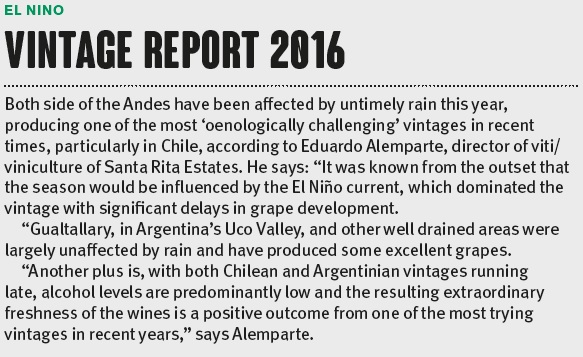Bodegas Fabre owner and wine-maker Hervé Joyeux Fabre says: “I believe that, internationally, Argentina has managed to position itself very well as consumers perceive our wines as being reasonably premium while providing outstanding value for money. In addition, our finest wines are gaining market share year on year.
“For producers, the main challenge is being able to maintain a high standard of quality while breaking even financially – given that we have a 30% inflation rate in Argentina and we are competing with other countries with a more favourable exchange rate.
“But we have the opportunity to position our ‘national grape variety’ as a ‘classic’ by looking at examples from France or other countries, rather than just producing Malbec because it is trendy.
The only way we will be able to make Malbec a truly international grape variety is by looking at what other countries are doing and by offering several alternative styles,” says Fabre.
Catena says: “To me, there are many similarities between the different styles of Pinot Noir in Burgundy and the styles of Malbec in Argentina. Like Pinot Noir, Malbec has delicate fruit aromas and varies depending on the soils where it is grown. Malbec likes a climate which is not too hot and that is why we grow our best Malbec at high altitude, above 1,000ft elevation. Also, we have extraordinarily diverse populations of Malbec – pre-phylloxeric – in Argentina, and similar to the Pinot Noir populations in Burgundy, we think this diversity makes wines that are more elegant and expressive.”
Finca Flichman chief winemaker German Berra sounds a note of warning. “Climate change is a big concern for farmers. Our vine growing regions are typically dry and we are experiencing an increase in rainfall that could affect yields and quality if we don’t research how to manage the vineyards properly under new conditions. “
OTHER VARIETIES & STYLES
Doña Paula winemaker Marcos Fernandez says: “Cabernet Franc is showing great potential in terms of quality concentration and potential of ageing. But we have to increase the planted hectares to reflect more opportunities of growing.
“Cabernet Sauvignon is the biggest growing in terms of sales, also Bordeaux blends based on Malbec reflect this. I think Malbec had opened the door and now consumers feel confident to taste other things from Argentina.”
Sebastian Zuccardi says another of Argentina’s strengths is its diversity. “We are not only Malbec, we have other unique strains, such as Bonarda and Torrontés. Bonarda has great adaptability, is a very juicy grape to make wines with less tannin structure and it works very well.”
Fabre says: “We all agree that Argentina can produce some outstanding wines from other varieties than Malbec. It is still relatively difficult for Argentinian Cabernet Sauvignon or Chardonnay to compete with similar wines from other countries which have a longer history of production. For varieties such as Cabernet Franc and Sauvignon Blanc, it can be difficult for Argentina to provide a credible offer given the very small vineyard area dedicated to those varieties.
“With Viñalba, Bodegas Fabre chose to offer alternatives with Malbec based on dual varietal wines such as Malbec/ Cabernet Sauvignon, Malbec/Cabernet Franc, Malbec/Syrah, Malbec/Petit Verdot, Malbec/Touriga Nacional.
“We believe it is the best way to encourage consumers to try the other varieties which Argentina can offer,” says Fabre.
Enotria & Coe’s Vianna says: “The greatest challenge (for Argentina) is to get consumers to appreciate Torrontes, among other grape varieties, and not to be perceived as a country that only produces Malbec.




